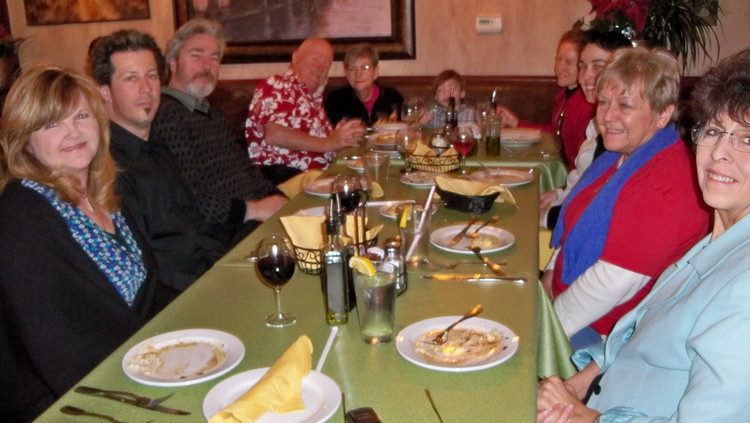Annual Naples Walk Of Lights
It's simply TRADITION! A tradition is a practice, custom, or story that is memorized and passed down from generation to generation, originally without the need for a writing system. Tools to aid this process include poetic devices such as rhyme and alliteration. The stories thus preserved are also referred to as tradition, or as part of an oral tradition.
Traditions are often presumed to be ancient, unalterable, and deeply important, though they may sometimes be much less "natural" than is presumed. Some traditions were deliberately invented for one reason or another, often to highlight or enhance the importance of a certain institution

We began at Preveza...
Sharon Boyce joined the happy clan

Theo was himself... Fantastic

Greg was next door with the Catholic contengent

Naples Here We Are

It was a quick evening walk
Did you know? - In 1903 Arthur Parson built the islands of Naples in the marshy Bixby Slough of the artificial Alamitos Bay, in the mouth of the San Gabriel River. The design was by the firm Mayberry & Parker. The concept of canals and gondolas was similar to the "Venice of America" developed by Abbot Kinney up the coast. Parson's Naples Land Company called its plans the "Dreamland of Southern California", and projected that "through the canals and under the high arching bridges gay gondoliers will propel their crafts like those in the waters of the Adriatic under the blue skies of Italy." The project was completed in the 1920s, then rebuilt after the 1933 Long Beach earthquake.

Let's walk...


Wild life everywhere... Even on the sidewalks!


Great reflections

Excellent landing spot for Santa

Everybody had a happy face
Did you know? - A smiley, a.k.a. happy face, is a stylized representation of a smiling human face, commonly represented as a yellow (many other colors are also used) circle (or sphere) with two black dots representing eyes and a black half circle representing the mouth. “Smiley” is also sometimes used as a generic term for any emoticon. The variant spelling "smilie" is not as common, but the plural form "smilies" (the plural of "smily", not "smiley") is commonly used


So do we!



Watch out for deer droppings
Did you know? - After an animal has digested eaten material, the remains of that material are expelled from its body as waste. Though it is lower in energy than the food it came from, feces may still contain a large amount of energy, often 50% of that of the original food. This means that of all food eaten, a significant amount of energy remains for the decomposers of ecosystems.


Sheri looks like she needs a push




Keep your head low


See the boat??

Robin and Bob made a hit with Theo


Lights galore
Did you know? - Early Christians were persecuted for having worship gatherings ("mass"). A candle in the window signified where worship would be occurring for Christians in a community.
he tradition of using small candles to light up the Christmas tree dates back to at least the middle of the 17th century. However, it took two centuries for the tradition to become widely established first in Germany and soon spreading to Eastern Europe.
andles for the tree were glued with melted wax to a tree branch or attached by pins. Around 1890, candleholders were first used for Christmas candles. Between 1902 and 1914, small lanterns and glass balls to hold the candles started to be used.
The illuminated Christmas tree became a Christmas tradition in Germany during the Early Modern period. The illuminated Christmas tree became established in the United Kingdom during Queen Victoria's reign, and through emigration spread to North America and Australia. In her journal for Christmas Eve 1832, the delighted 13-year-old princess wrote, "After dinner..we then went into the drawing-room near the dining-room. There were two large round tables on which were placed two trees hung with lights and sugar ornaments. All the presents being placed round the trees". Until the development of inexpensive electrical power in the mid nineteenth century, miniature candles were commonly (and in some cultures still are) used.


"I is a Caribou.. I is!"

"Ps-s-s-s-s-t Santa, look at those funy humans"


Kiss the froggy Theo

"Global warming my butt! I'm freezing out here!"



Peeping Tom's???

A Christmas Death Star


Good size for the tree
Did you know? - A bauble is a spherical decoration that it commonly used to adorn Christmas trees. The bauble is one of the most popular Christmas ornament designs, and they have been in production since 1847. Baubles can have various designs on them, from "baby's first Christmas," to a favorite sports team. The Polish name for these things is bombka (which translates as "a little bomb").

Did you know? - The first decorated trees were adorned with apples, strings of popcorn, white candy canes and pastries in the shapes of stars, hearts and flowers. Glass baubles were first made in Lauscha, Germany, by Hans Greiner who produced garlands of glass beads similar to the popcorn strands and tin figures that could be hung on trees. The popularity of these decorations grew into the production of glass figures made by highly skilled artisans with clay molds.
The artisans heated a glass tube over a flame, then inserted the tube into a clay mold, blowing the heated glass to expand into the shape of the mold. The original ornaments were only in the shape of fruits and nuts.
After the glass cooled, a silver nitrate solution was swirled into it, a silvering technique developed in the 1850s by Justus von Liebig. After the nitrate solution dried, the ornament was hand-painted and topped with a cap and hook



"Hi Hello"




Oh dear






Let's Eat







